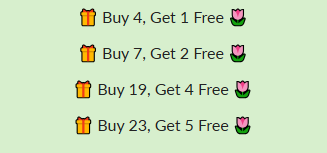How to Sow and Plant
Sow in directly in the garden in fertile, warm soil after danger of frost has passed. Cucumber seeds will not germinate in soil colder than 60 degrees.
Sow seeds 3 inches apart in groups of 4-6. Cover with ½ inch of fine soil.
Space groups 19 to 26 inches apart each way.
Keep evenly moist.
Seedlings emerge in 7-14 days.
Thin to 3 or 4 strongest seedlings in each group when they are 1-2 inches high.
How to Grow
Keep weeds under control during the growing season. Weeds compete with plants for water, space and nutrients, so control them by either cultivating often or use a mulch to prevent their seeds from germinating.
Cucumbers have a shallow root system, mulches help retain soil moisture and maintain even soil temperatures.
Keep plants well-watered during the growing season, especially during dry spells. Plants need about 1-2 inches of rain per week during the growing season. Use a rain gauge to check to see if you need to add water. It's best to water with a drip or trickle system that delivers water at low pressure at the soil level. If you water with overhead sprinklers, water early in the day so the foliage has time to dry off before evening, to minimize disease problems. Keep the soil moist but not saturated.
As plants grow mulch to control weeds, keep fruits off the ground and conserve moisture
Do not move the vines, they are easily injured.
Monitor for pests and diseases. Check with your local Cooperative Extension Service for pest controls recommended for your area.
When cucumber seeds are direct-sown along a cucumber fence, vines can be trained to grow upright for easy picking and to save space for other plants to grow. Good companion vegetable plants are direct-sown radishes, bush snap beans, and transplants of compact herbs, peppers, eggplants and tomatoes. Attract bee pollinators by planting daisies such as sunflowers, cosmos, zinnias and coneflower, and mints such as bee balm, sage, oregano and lavender. More bees mean more chances flowers will be pollinated and develop into fruits.
Tips
Like most vegetables, cucumbers are tender and tastiest when harvested young before their seeds are fully developed.
Slicing cucumber varieties are generally ready for harvest when about six to eight inches long; pickling cucumber types at three to five inches- both in about 50-60 days from seeding.
To avoid damage cut fruit from the vine rather than pull
Don't allow the fruits to become overripe on the vine as this signals to the plant that the seed-development process is nearly complete and it will shut down.
Keep mature cucumber fruits picked to encourage further production. During hot weather cucumbers grow very fast, you may need to harvest every day.
Harvest the cucumber fruits early in the morning before the sun hits them for the best flavor and texture.
Second:💰 Money-Back Guarantee: If you have any quality problems with the product within 30 days of purchase, we will gladly issue out a replacement or refund.
Third:✉️ Customer Support: We have a team of live reps ready to help and answer any questions you have within a 8-hour time frame, 5 days a week.
Fourth:🔒 Safe & Secure Checkouts: We use state-of-the-art SSL Secure encryption to keep your personal and financial information 100% protected.
Every shopping experience is a new experience full of expectations. If there are any problems with the seeds you received or the logistics process, please contact us by email first. We promise to follow up and handle it for you as soon as possible: whether you need to resend the goods or want a refund service, we will respond as quickly as possible. Your satisfaction is our primary pursuit!









